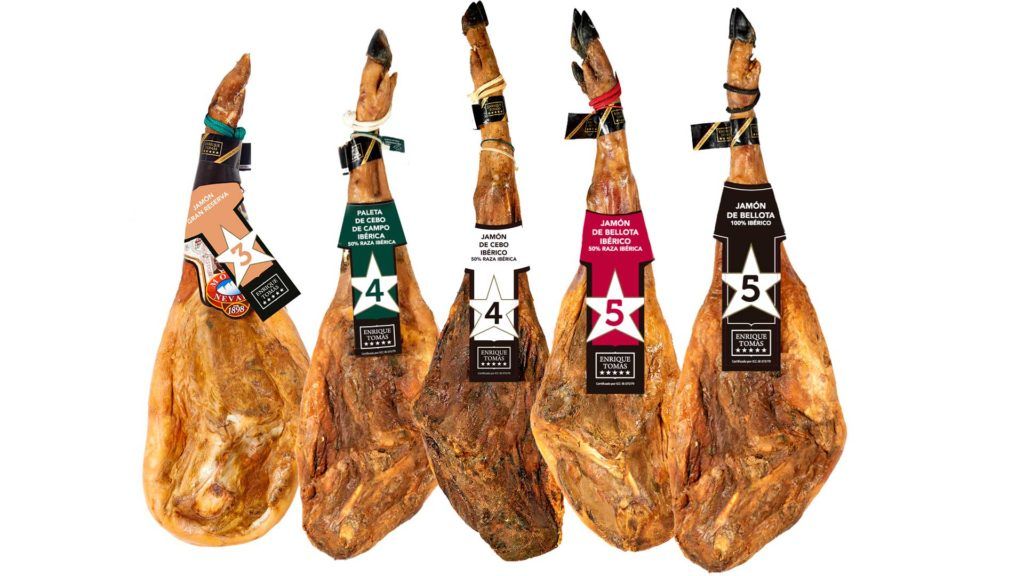
How to make an Iberian ham tasting at home
Eating ham should always give pleasure and nothing better than a shared pleasure. If you are an expert or you dare to prepare a different evening to surprise, we encourage you to try an Iberian ham tasting , without a doubt the best way to discover the different flavors and nuances that the different qualities of the same product can offer: Ham Iberian.
The types of ham
Ham is one of the star products of Spanish gastronomy, a flag that unites us all and a food that should not be missing in any celebration, but there are many hams!
We will start by talking about the most basic distinction, the one that is given by the breed of the pig. White or non-Iberian pigs produce what we know as Gran Reserva Ham and within this category we find three types of ham according to their curing in cellars:
-
Cellar Ham
-
Reserve Ham
-
Gran Reserva Ham
The Iberian pigs, unique in the world and native to the Iberian Peninsula, are the producers of the famous Iberian ham. For its part, Iberian ham also has classifications according to the percentage of purity of the breed and the food that the animal has enjoyed during its upbringing, so we find:
-
Iberian bait Ham
-
Cebo de Campo Iberico Ham (formerly known as Recebo Ham)
-
Acorn-fed Iberico Ham
-
100% Iberico Bellota Ham
Enrique Tomás hams from left to right: Gran Reserva 3*, Ibérico Cebo de Campo 4*, Ibérico de cebo 4*, Bellota 50% Iberico 5*, Bellota 100% Iberico 5*
So, when we talk about Iberian ham tasting, we have a range of important options since we can do a tasting according to percentages of breed purity, according to origins or even according to the type of food the pig has received.
Once you are clear about which of these types of tastings you are interested in preparing, everything will be very simple.
Organize an Iberian ham tasting in 3 steps
When organizing an Iberian ham tasting at home, the most important thing is to have the ham that we want to try, then present it properly and finally pair it with a drink that allows us to enhance the flavors. But that yes, before encouraging you to organize your own tasting, from Enrique Tomás we advise you to attend some led by professionals because in this way, in addition to having an incredible time, you will learn everything you need to know about ham to share in your own tasting
So let's go with the 3 steps to organize a ham tasting.
Tasting type
The Iberian ham tasting can be done in different ways, the first one is with all types of Iberian ham (selection) to taste the difference in flavor according to the pig's diet. For this type of tasting we would need:
- Iberico Cebo Ham (50-75% Iberico)
- Cebo de Campo Iberico Ham (50-75% Iberico)
- Acorn-fed Iberico Ham (50-75%-100% Iberico)
Another type of tasting that we can do is the tasting according to the flavors of Enrique Tomás. In this case, the tasting will focus on the difference in aromas and intensity of flavor in relation to the place where the piece has been cured. For this we must have:
- Mild Acorn-fed Iberico Ham (50-75-100% Iberico)
- Intense Acorn-Fed Iberico Ham (50-75-100% Iberico)
- Aromatic Acorn-fed Iberico Ham (50-75-100% Iberico)
- Sabroso Acorn-fed Iberico Ham (50-75-100% Iberico)
It must be taken into account that the percentage of purity of the breed implies palpable differences in the flavor of the ham, therefore, when doing a tasting of Iberian ham according to flavors, we must always use the same quality of product, choosing between 50% Iberian products, 75% Iberian products or the highest quality, 100% Iberian Bellota Ham.
Presentation of the Ham
The presentation in a tasting is very important, let's remember that the ham must give pleasure and this must be achieved with all the senses, including sight.
- Always use unicolor dishes, preferably white, so that the color of the ham stands out as the only protagonist.
- Never mix the different types of ham to taste, you can place it on the same plate but giving each one their space so that they are not confused or mixed. You can also gradually serve and present the types of ham, giving diners time to enjoy and share the flavors they have discovered after each bite.
- Accompany the session with Sevillian peaks or scolding. These crusty bread morsels help cleanse the palate and neutralize flavors; in this way it will be much easier to distinguish the differences between the different types of ham.

Pairing
The issue of pairing ham is a world apart, but when it comes to tasting the differences in flavors between the different types of Iberian ham, there is nothing like accompanying the evening with a glass of very cold cava. Cavas Brut Nature and Gran Reserva will provide a degreasing effect that will complement perfectly while being able to harmonize with the nuances of the ham.
In any case, there are no rules here, so don't hesitate and go ahead and pair your tasting of Iberian ham with wine, water or beer and try the different sensations that appear on your palate with each of these drinks after a bite of ham.
Remember that knowledge is power, so if you want to know in depth the world of ham and the theory behind these differences in flavor in each type of ham, get a copy of Jamón para Dummies , the book by Enrique Tomás and Editorial Planet with which you will become an expert in the field of ham.















